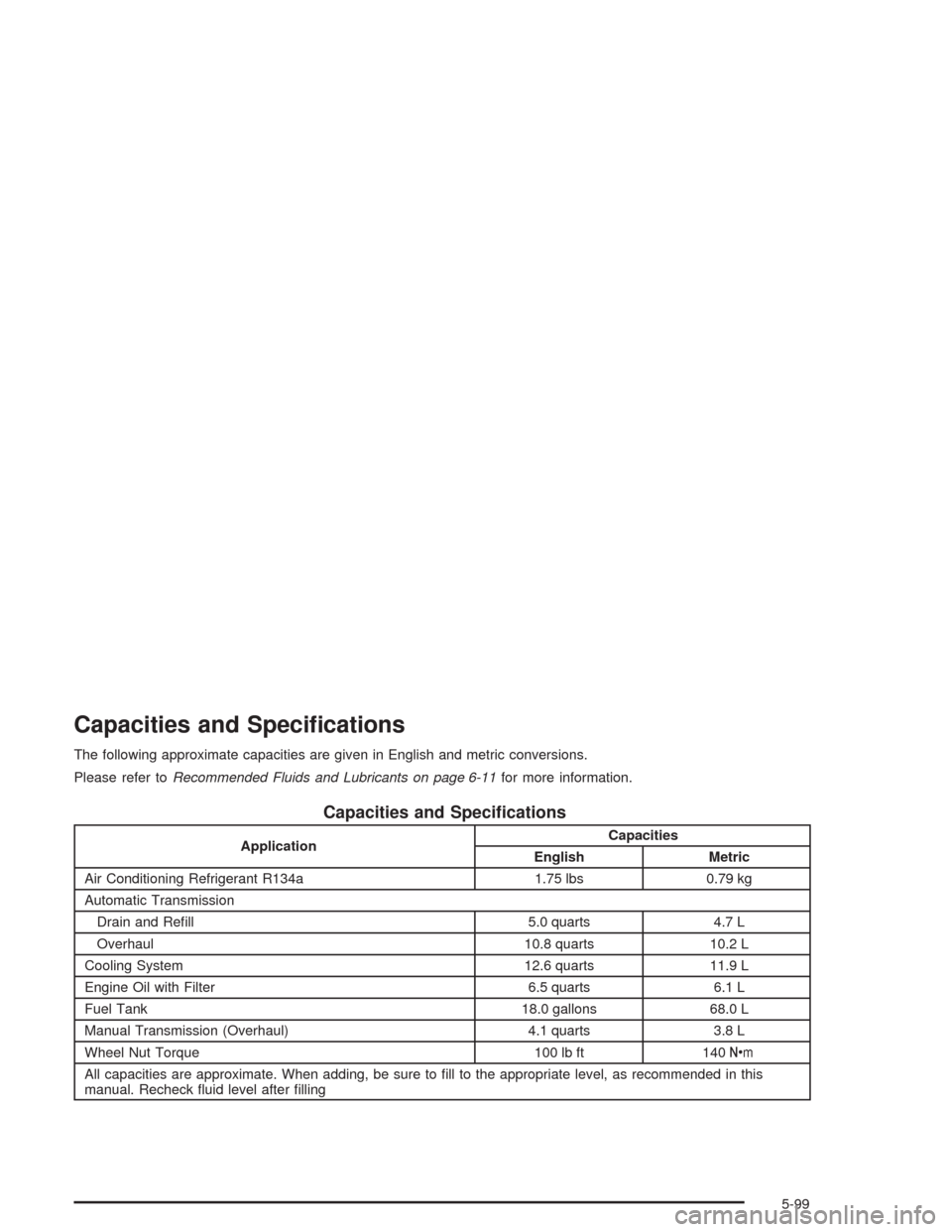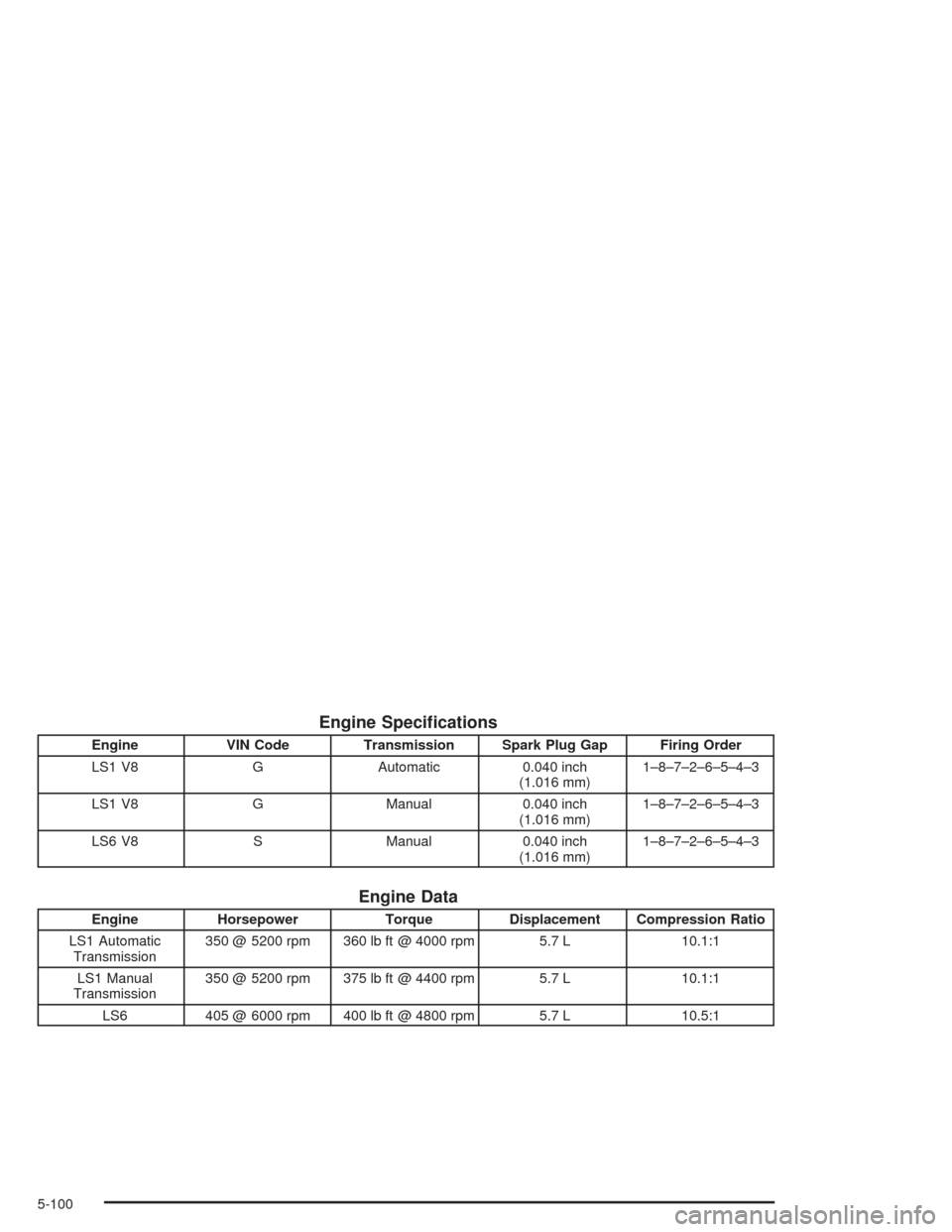2004 CHEVROLET CORVETTE torque
[x] Cancel search: torquePage 83 of 384

THIRD (3):This position is also used for normal driving.
However, it offers more power and lower fuel economy
than AUTOMATIC OVERDRIVE (
X).
Here are some times you might choose THIRD (3)
instead of AUTOMATIC OVERDRIVE (
X):
•When driving on hilly, winding roads.
•When going down a steep hill.
SECOND (2):This position gives you more power but
lower fuel economy than THIRD (3). You can use
SECOND (2) on hills. It can help control your speed as
you go down steep mountain roads, but then you
would also want to use your brakes off and on.
If you manually select SECOND (2) when you start the
vehicle, the transmission will drive (and stay) in
second gear. You may use this feature for reducing
torque to the rear wheels when you are trying to start
your vehicle from a stop on slippery road surfaces, or for
preventing the transmission from downshifting into
FIRST (1) in situations where a downshift would
be undesirable.FIRST (1):This position gives you even more power,
but lower fuel economy, than SECOND (2). You can use
it on very steep hills, in deep snow or mud. If the shift
lever is put in FIRST (1), the transmission will not
shift into first gear until the vehicle is going slowly
enough.
Notice:Spinning the tires or holding the vehicle in
one place on a hill using only the accelerator
pedal may damage the transmission. If you are
stuck, do not spin the tires. When stopping on a hill,
use the brakes to hold the vehicle in place.
Maximum engine speed is limited to protect driveline
components from improper operation.
2-27
Page 90 of 384

Torque Lock (Automatic Transmission)
If you are parking on a hill and you do not shift your
transmission into PARK (P) properly, the weight of the
vehicle may put too much force on the parking pawl
in the transmission. You may find it difficult to pull the
shift lever out of PARK (P). This is called “torque
lock.” To prevent torque lock, set the parking brake and
then shift into PARK (P) properly before you leave
the driver’s seat. To find out how, see “Shifting
Into PARK (P)” listed previously in this section.
When you are ready to drive, move the shift lever out of
PARK (P) before you release the parking brake.
If torque lock does occur, you may need to have another
vehicle push yours a little uphill to take some of the
pressure from the transmission parking pawl, so you can
pull the shift lever out of PARK (P).
Shifting Out of Park (P)
Your vehicle has an automatic transmission shift lock
control system which locks the shift lever in PARK (P)
when the ignition is in the off position. In addition,
you have to fully apply your regular brake before you
can shift from PARK (P) when the ignition is in ON. See
Automatic Transmission Operation on page 2-25.
As a reminder, you will see a message in the Driver
Information Center (DIC) that will say PRESS BRAKE
BEFORE SHIFT within 15 seconds unless the brake
is pressed.
If you cannot shift out of PARK (P), ease pressure on
the shift lever and push the shift lever all the way
into PARK (P) and release the shift lever button as you
maintain brake application. Then press the shift lever
button and move the shift lever into the gear you wish.
2-34
Page 175 of 384

HIGH TIRE PRESSURE – (LF, LR, RF, RR)
(Except Z06):You will hear two chimes when this
message is displayed. To acknowledge the warning,
press RESET. After you press RESET, a message will
reappear every 10 minutes until this condition
changes. This message indicates that the pressure in
one of your tires is higher than 42 psi (290 kPa). Next to
the HIGH TIRE PRESSURE message, you can see
either LF (left front), LR (left rear), RF (right front) or RR
(right rear) to indicate to you which tire is higher than
42 psi (290 kPa). You can receive more than one
tire pressure message at a time. To read other
messages that may have been sent at the same time,
press RESET. If a tire pressure message appears on the
DIC, stop as soon as you can. Have the tire pressures
checked and set to those shown on your Tire Loading
Information Label. SeeExtended Mobility Tires
(Except Z06) on page 5-61andIn�ation - Tire
Pressure on page 5-62.HIGH TRANS TEMP (Automatic Transmission
Only):You will hear four chimes when this message is
displayed. To acknowledge this warning, press the
RESET button. After you press the RESET button, the
message will be displayed every 10 minutes until
the condition changes. If you do not press RESET, the
message remains on the display until the condition
changes.
If the transmission fluid temperature rises above 270°F
(132°C) or rises rapidly, this message is displayed.
The transmission may shift gears or apply the torque
converter clutch to reduce the fluid temperature. Driving
aggressively or driving on long hills can cause the
transmission fluid temperature to be higher than normal.
If this message appears, you may continue to drive at
a slower speed. You should also monitor the
transmission fluid temperature and allow it to cool to at
least 230°F (110°C). The transmission fluid temperature
can be monitored with the GAGES button on the
DIC. SeeAutomatic Transmission Fluid on page 5-20.
You should also check the engine coolant temperature.
If it is also hot, seeEngine Overheating on page 5-26.
If the HIGH TRANS TEMP message is displayed during
normal vehicle operation on flat roads, your vehicle
may need service. See your dealer for an inspection.
3-61
Page 312 of 384

{CAUTION:
Incorrect wheel nuts or improperly tightened
wheel nuts can cause the wheel to become
loose and even come off. This could lead to a
crash. Be sure to use the correct wheel nuts. If
you have to replace them, be sure to get new
GM original equipment wheel nuts.
Notice:Improperly tightened wheel nuts can lead
to brake pulsation and rotor damage. To avoid
expensive brake repairs, evenly tighten the wheel
nuts in the proper sequence and to the proper
torque speci�cation.
Magnesium Wheels
Notice:If your vehicle has magnesium wheels,
moisture on or around the mounting surface of the
magnesium wheel will cause corrosion and
damage to the wheel. To help prevent this, a
magnesium wheel uses two rubber O-rings. One
goes on the inboard side of the wheel and the other
on the back of the center hubcap. When you put
a magnesium wheel back on, be sure the O-rings are
correctly installed. On the inboard side, of the
wheel, work the O-ring into the groove. When
properly installed, this O-ring �ts snugly. The other
O-ring goes around the retaining legs of the
center cap.
Used Replacement Wheels
{CAUTION:
Putting a used wheel on your vehicle is
dangerous. You can’t know how it’s been used
or how far it’s been driven. It could fail suddenly
and cause a crash. If you have to replace a
wheel, use a new GM original equipment wheel.
5-70
Page 341 of 384

Capacities and Speci�cations
The following approximate capacities are given in English and metric conversions.
Please refer toRecommended Fluids and Lubricants on page 6-11for more information.
Capacities and Speci�cations
ApplicationCapacities
English Metric
Air Conditioning Refrigerant R134a 1.75 lbs 0.79 kg
Automatic Transmission
Drain and Refill 5.0 quarts 4.7 L
Overhaul 10.8 quarts 10.2 L
Cooling System 12.6 quarts 11.9 L
Engine Oil with Filter 6.5 quarts 6.1 L
Fuel Tank 18.0 gallons 68.0 L
Manual Transmission (Overhaul) 4.1 quarts 3.8 L
Wheel Nut Torque 100 lb ft 140Y
All capacities are approximate. When adding, be sure to fill to the appropriate level, as recommended in this
manual. Recheck fluid level after filling
5-99
Page 342 of 384

Engine Speci�cations
Engine VIN Code Transmission Spark Plug Gap Firing Order
LS1 V8 G Automatic 0.040 inch
(1.016 mm)1–8–7–2–6–5–4–3
LS1 V8 G Manual 0.040 inch
(1.016 mm)1–8–7–2–6–5–4–3
LS6 V8 S Manual 0.040 inch
(1.016 mm)1–8–7–2–6–5–4–3
Engine Data
Engine Horsepower Torque Displacement Compression Ratio
LS1 Automatic
Transmission350 @ 5200 rpm 360 lb ft @ 4000 rpm 5.7 L 10.1:1
LS1 Manual
Transmission350 @ 5200 rpm 375 lb ft @ 4400 rpm 5.7 L 10.1:1
LS6 405 @ 6000 rpm 400 lb ft @ 4800 rpm 5.7 L 10.5:1
5-100
Page 382 of 384

Steering Wheel, Tilt Wheel................................. 3-5
Storage Areas
Center Console Storage Area........................2-40
Convenience Net.........................................2-43
Cupholder(s)...............................................2-40
Glove Box..................................................2-40
Rear Storage Area.......................................2-42
Storing the Roof Panel....................................2-47
Stuck in Sand, Mud, Ice or Snow......................4-32
Sun Visors.....................................................2-15
T
Tachometer....................................................3-34
Taillamps
Turn Signal Lamps......................................5-50
TCS Warning Light..........................................3-39
Telescopic Steering Column............................... 3-6
Testing the Alarm............................................2-17
Theft-Deterrent, Radio.....................................3-86
Theft-Deterrent System....................................2-16
Theft-Deterrent Systems...................................2-16
PASS-Key
®.................................................2-18
Tilt Wheel........................................................ 3-5
Tire Inflator Kit Storage....................................5-81
Tire Inspection and Inflation Check...................... 6-9
Tire Sealant...................................................5-78
Tire Sidewall Labeling......................................5-55
Tire Size Codes..............................................5-57Tire Terminology and Definitions........................5-58
Tires.............................................................5-55
Buying New Tires........................................5-66
Chains.......................................................5-71
Extended Mobility........................................5-61
If a Tire Goes Flat.......................................5-75
Inflation - Tire Pressure................................5-62
Lifting Your Vehicle......................................5-71
Pressure Monitor Operation...........................5-64
Rotation.....................................................5-65
Tire Inflator Kit............................................5-77
Uniform Tire Quality Grading.........................5-67
Wheel Alignment and Tire Balance.................5-68
Wheel Replacement.....................................5-68
When It Is Time for New Tires......................5-65
To Use The Engine Coolant Heater...................2-24
Top Strap......................................................1-28
Top Strap Anchor Location...............................1-30
Torque Lock (Automatic Transmission)...............2-34
Towing
Recreational Vehicle.....................................4-33
Towing a Trailer..........................................4-38
Your Vehicle...............................................4-33
Traction
Active Handling System................................4-10
Control System (TCS).................................... 4-9
Control System Warning Light.......................3-39
Limited-Slip Rear Axle..................................4-12
Selective Ride Control..................................4-12
12